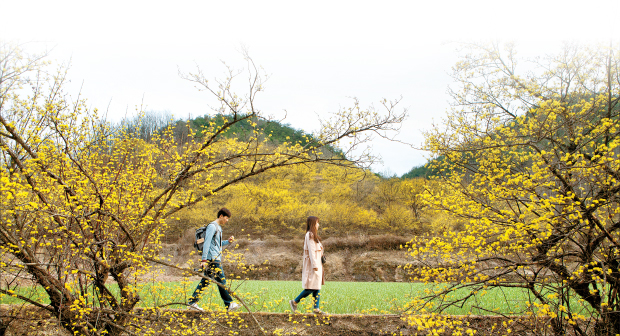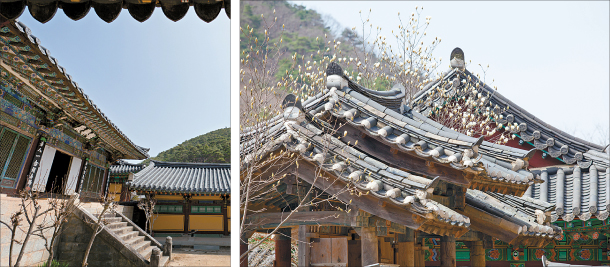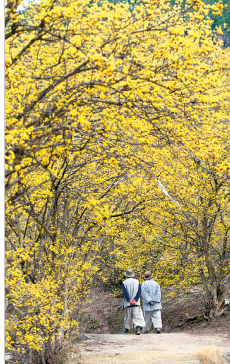Uiseong paints itself yellow to welcome spring

Sansuyu village in Uiseong, North Gyeongsang, is a beautiful district filled with yellow sansuyu, or cornus flowers. [CHOI SEUNG-PYO]
“There aren’t many places to eat around the Sansuyu village. You should go out of town to eat and then come back,” Noh Hun, the secretary general of the village in Uiseong told me upon my visit to his neighborhood.
I decided to visit the Uiseong Gongseol Market for a meal, but the place was nearly empty. When I went inside the shops, I saw women peeling garlic and men chatting inside of an old blacksmith’s workshop. With its quiet atmosphere, the market felt quite lethargic.
As I drove out of the market, I came across the beautiful scenery of Sansuyu village. This village was like a messenger of spring, covered in beautiful yellow cornus flowers. Just 20 minutes away from the market, I reached Hwajeon-ri, which is where the entrance of the Uiseong Sansuyu village is located. (The suffix -ri translates to district in Korean.) The magnificent sight before me was the exact same one from the recent movie “Little Forest.” In the film, Hye-won, the main character, rides her bike down a narrow farm road, and to her left is a green garlic field and to her right are sansuyu trees. The exact same scene played out right in front of me.

Hanok, or traditional Korean houses, left and center, can be found in Uiseong’s Sachon village. Goun Temple, right, is a place where visitors can not only experience temple food and culture, but also walk along a stunning trail covered in wild flowers. [CHOI SEUNG-PYO]
Uiseong’s Sansuyu Flower Festival, one of the region’s biggest events of the year, began in 2003. Unfortunately, due to an avian influenza, the festival had to be discontinued last year. This year, the festival was reduced to a “Flower Event.” But because the event is run by the Sansuyu villagers instead of the county, it is not as extravagant as flower festivals in other districts. However, according to locals, the flowers blossom beautifully every year, and because the district is not crowded with people, it is the perfect place to enjoy the scenery.
Compared to the wide plains in Hwajeon 3-ri, Hwajeon 2-ri is more secluded in a mountain valley. When I went to an observatory on a mountain behind the village, I took in the magnificent view of the cozy-looking village. Every direction I looked within the valley looked like it was covered in yellow paint.
On my way down from the observatory, I saw members of the village women’s organization busy preparing for events. They were cooking tofu in iron pots and cleaning vegetables. One old lady named Bae Yeong-hee, who was selling dried sansuyu, black beans and peanuts at a roadside stand let out a sigh of exasperation.

Garlic is the most important crop in Sansuyu village. Sales of the crop account for 80 percent of villagers’ annual incomes. Last year’s garlic harvest in Sagok-myeon added up to 2,085 tons, which was the second largest harvest in the country.
Im Sun-ja, a woman who was preparing food for the community’s event boasted about the region’s garlic. “Once you try the Uiseong garlic, other garlics start to taste bland. Even the woman’s curling team said they got their strength from garlic covered in honey,” said Im.
Just as Im said, Uiseong garlic does have a unique appeal. The garlic grown here is different from others in that the seeds are smaller and more solid. It has a strong, spicy and sweet flavor and contains allicin, which is filled with high levels of antioxidants that remove harmful toxins from the body. Villagers say the secret to the special taste of Uiseong garlic is the volcanic soil from Mount Geumseong, which is a dormant volcano.
Uiseong has more to offer besides sansuyu and garlic. Starting in June, the curling center in Uiseong will be open for the public. Also, for those interested in cultural sights, Uiseong is a great place to visit. The county is home to the Jomunguk Museum where you can find many historical artifacts from the Samhan Dynasty, a period before the Three Kingdoms Period (57 B.C. to 668 A.D.).
Goun Temple is also a must-see site in Uiseong. However, when going to this temple, be sure to strategically plan your routes, as Uiseong is twice the size of Seoul, with many narrow roads.
I visited both the village of Sachon and Goun Temple in the northern part of Uiseong. Unlike the secluded Sansuyu village, Sachon is filled with elegant hanok, or traditional Korean houses. You can also find Manchwidang, the most famous timber house in Korea, in this village. The roadside forest in Sachon is also exquisite. The forest is made up of bulky oak trees, zelkova trees and hackberry trees that were planted around 600 years ago, during the late Goryeo period (918-1392).
Goun Temple is a 20-minute drive from Sachon. This is a great place to not only experience temple food and culture, but also go for a lazy stroll surrounded by wild flowers.
BY CHOI SEUNG-PYO [sung.jieun@joongang.co.kr]
초록 마늘밭과 노랑 산수유꽃의 조화, 눈부신 의성의 봄날
“의성? 영미 고향?”
마늘의 고장 정도로 알려졌던 경북 의성군의 수식어가 달라졌다. 평창 겨울올림픽에서 은메달을 거머쥔 여자 컬링 국가대표 덕분이다. 컬링 선수 4명의 고향으로 알려지면서 위상은 높아졌지만 5만3000명이 사는 농촌은 딱히 달라진 게 없다. 봄이 오면 어김없이 일손이 바빠지고, 봄이 무르익으면 어김없이 산수유꽃이 만발한다.
“마을엔 마땅한 식당이 없심더. 읍에서 뭐라도 잡수고 오이소.”
지난달 29일 의성 산수유마을 노훈(58) 사무국장의 말을 듣고 의성공설시장부터 들렀다. 장날이 아니어서인지 시장은 한산했다. 어둑한 가게 안쪽에서 아낙들이 마늘을 까고 있었고, 오래된 대장간에선 촌로들이 담소를 나누고 있었다. 공기마저 나른한 시장은 전체가 춘곤증에 잠긴 듯했다.
읍내를 벗어나자마자 산수유의 고장을 증명하는 풍경이 펼쳐졌다. 912번 지방도의 가로수가 죄 산수유나무였다. 20분 만에 사곡면 화전리, 즉 의성 산수유마을 어귀에 다다랐다. 영화 ‘리틀 포레스트’에서 봤던 장면이 그대로 눈앞에 펼쳐졌다. 혜원(김태리)이 자전거 타고 좁은 농로를 달릴 때 길 왼편에는 초록 마늘밭이 싱그러웠고 오른편에 어른 키의 세 배는 족히 넘는 산수유나무가 샛노란 꽃을 틔웠다. 바로 그 풍경이었다.
김태리 대신에 노훈 사무국장과 꽃길을 걸었다. 노 국장이 먼저 안내한 곳은 산수유 시목지(始木地)였다. 노거수 세 그루가 가지를 축 늘어뜨리고 있었다. 조선 선조 13년(1580) 마을 벼슬로 부임한 노덕래(생몰 미상)가 개울둑이 무너지는 걸 막기 위해 심었다는 나무다. 화전 2, 3리에는 수령 300년이 넘는 산수유나무만 3만5000그루에 달한다. 비교적 최근에 심은 나무까지 더하면 10만 그루가 넘는다. 개울가, 논둑 뿐 아니라 동구길, 산등성이도 온통 노랗다.
산수유꽃축제는 2003년 시작했다. 하나 지난해와 올해는 된서리를 맞았다. 조류인플루엔자(AI) 때문이다. 지난해에는 아예 취소됐고, 올해는 ‘축제’가 아닌 ‘꽃맞이행사’로 축소됐다. 군청의 지원 없이 산수유마을 주민들이 주도하는 행사여서 다른 지역의 봄꽃축제보다 초라하다. 그러나 주민들 말마따나 꽃은 예년과 다를 게 없다. 도리어 방문객이 적어 차분하게 꽃을 감상하기엔 더 좋다.
비교적 넓은 평야가 있는 화전 3리와 달리 화전 2리는 산골짜기에 들어가 있어 아기자기했다. 사방이 산으로 둘려있고 다래넝쿨이 많아 예부터 ‘숲실’이라 불리던 마을이다. 마을 뒷산 전망대에 오르니 아늑한 마을 풍경이 고스란히 한눈에 들어왔다. 어느 방향을 둘러봐도 골짜기마다 노란 물감을 뿌려 놓은 듯했다.
전망대에서 내려오니 부녀회 회원들이 행사 준비하느라 분주했다. 가마솥에 두부를 찌고, 채소를 다듬는 손길이 바빳다. 길모퉁이에 좌판을 깔고 말린 산수유•서리태•땅콩 등을 파는 배영희(67) 할머니가 긴 한숨을 쉬었다.
“우린 쉴 틈이 없어요. 6월에 마늘 수확하면 그 자리에 모내기를 해요. 10월에 추수하고 11월에 마늘 심고 나면 이듬해 1월까지 산수유 열매 따서 말려야 해요. 틈틈이 콩과 고추도 거둬야 하고.”
산수유마을을 먹여 살리는 건 산수유만이 아니다. 사실 가장 중요한 작물은 마늘이다. 화전리 주민 수입의 80%가 마늘이란다. 지난해 사곡면 마늘 수확량은 2085t으로, 의성에서 금성면(2820t) 다음으로 많았다. 행사 음식을 준비하던 임순자(71) 할머니가 마늘 자랑에 열을 올렸다. “의성 마늘 먹다가 다른 거 먹으면 영 심심허지. 컬링 선수들이 꿀에 절인 마늘 먹고 힘냈다잖소.”
터무니없는 얘기는 아니다. 의성 마늘의 주종은 ‘한지(寒地)형 마늘’이다. 우리가 흔히 먹는 난지형보다 씨알이 작고 옹골차다. 매운맛과 단맛이 강하고 살균작용을 하는 ‘알리신’ 함유량이 많다. 사화산(死火山)인 금성산(530m)에서 나온 화산 토질과 큰 일교차가 의성 마늘 맛의 비결이란다.
산수유와 마늘 말고도 의성의 자랑거리는 많다. 의성을 전국에 알린 주인공은 컬링이지만, 의성컬링센터는 일반인이 이용할 수 없다(6월 일반인을 위한 컬링체험장이 개장한다). 대신 문화유산이 많다. 삼한시대 초기 국가인 ‘조문국’의 유적, 천년고찰 고운사가 유명한데 동선을 잘 짜야 한다. 의성 면적은 서울의 두 배에 가깝고 꼬불꼬불한 산길과 비좁은 도로가 많아서다.
의성 북부의 사촌마을과 고운사를 들렀다. 사촌마을은 궁벽한 산수유마을과 딴판이었다. 너른 평야지대에 기품이 느껴지는 한옥이 모여 있었다. 마을에는 한국 최고(最古) 목조주택인 만취당도 있다. ‘사촌가로숲’도 근사하다. 약 600년 전인 고려 말에 조성한 숲으로, 우람한 상수리나무•느티나무•팽나무가 빽빽하다.
고운사는 사촌에서 자동차로 20분 거리다. 템플스테이•사찰음식체험 같은 일반인을 위한 프로그램이 많은데 봄에는 느긋하게 산책만 해도 좋다. 야생화가 지천이다. 가운루에서 내다본 산사의 풍경이 근사하고, 우화루 뒷마당에 앉으면 지붕들 위로 등운산(624m)의 고운 자태가 보인다.
최승표 기자










with the Korea JoongAng Daily
To write comments, please log in to one of the accounts.
Standards Board Policy (0/250자)